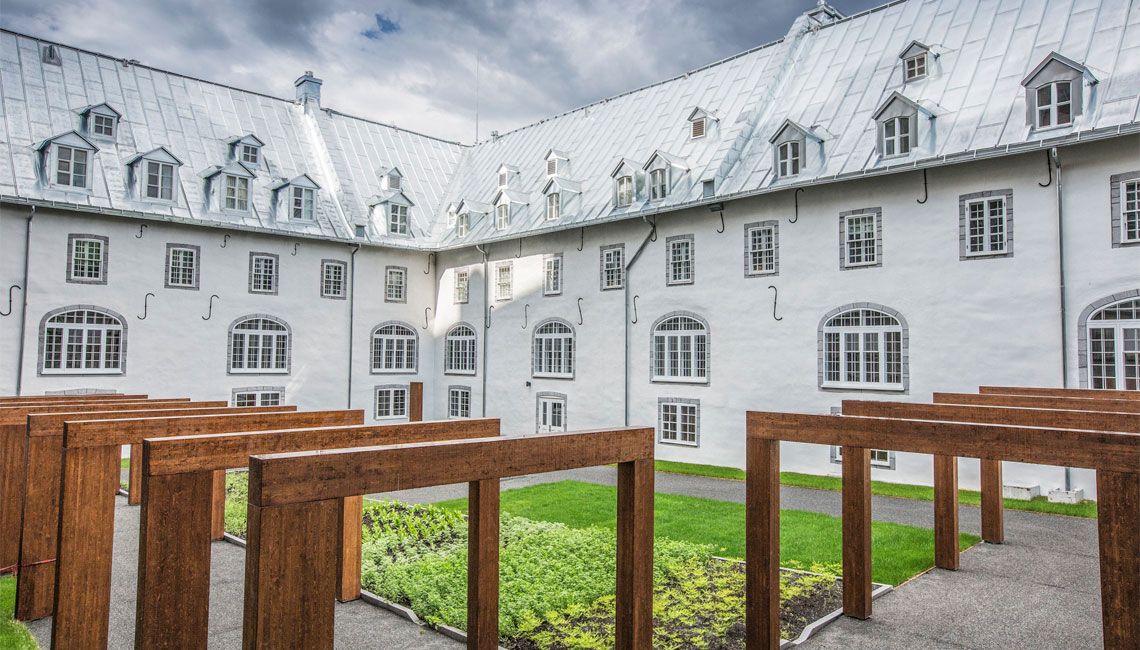Museums, spotlight on gardens… Discover some well-kept secrets!
Claude Benoit, muséologue

From Grand-Métis to Montréal, from Jardin des souvenirs to medicinal plant gardens, from horticultural sculptures to Sharecroppers’ gardens… Fabulous gardens await only you!
The versatile Grand-Métis gardens!
Whether you are a designer, artist, lover of landscape architecture, or just plain curious, an inspiring and revitalizing haven is to be found at the International Garden Festival. Faithfully representing the vision of Elsie Reford, an avant-garde gardener, the Festival is recognized as the largest of its kind in North America and among the main garden festivals on the international scene.
Serving as a forum for innovation and an experimentation laboratory, these gardens are must-see destinations, featuring inventive and imaginative spaces that bring together the visual arts, architecture, design, landscaping and the environment. Expect to be immersed for hours in this change of scenery at the heart of a mosaic of versatile gardens!
Jardins de Métis in the Museums guide
Rain and memories in the gardens of the Musée de la mémoire vivante

Upon arrival at the Musée de la mémoire vivante in Saint-Jean-Port-Joli, the exceptional nature of the gardens will enthrall you. In the Jardin de pluie, run-off water from the parking lot is decontaminated and channelled to form an artificial lake surrounded by flower beds, in which flora and fauna now abound. Thanks to the contributions from partners, this concrete gesture conveys the commitment of an entire community to protect and manage resources in a responsible way.
In the Jardin des souvenirs, citizens have tapped into the power of plants and flowers as “memory triggers,” in order to share memorable moments from their own lives. To this end, the Musée has planted rustic rose bushes, recalling for some the creation of rose petal rosary beads, and for others fond memories of their grandparents’ flower beds or the sweet taste of wild-rose-berry jelly. Feel free to add your own stories!
Le Monastère des Augustines: An open-air pharmacy

Discreetly ensconced in the courtyard of Le Monastère des Augustines in Québec City, the apothecary’s square consists of medicinal plants from the Old and New Worlds. It serves as a reminder that botany played an important role in caring for the sick during the 17th and 18th centuries. It celebrates the discovery of flora with unexpected virtues – a legacy of the Amerindians left to the first settlers, Louis Hébert, the first apothecary; and his wife, Marie Rollet. It also pays homage to the Augustinians, who have brought forward the apothecary knowledge that is preserved today.
Canadian maidenhair fern to treat asthma, rhubarb as a laxative, hops for a deep sleep, Canadian columbine to treat throat ulcers, oatmeal to hydrate the skin… You’ll find all of these remedies at your fingertips in this pharmacy!
A glimpse of New France at Château Ramezay

In the heart of Montréal’s historic district, and in the shadows of City Hall, the Château Ramezay residence, a sumptuous legacy of New France, can be found. Within its walls, visitors are invited to discover the Governor’s Garden, a remarkable example of 18th-century urban green space, its orchard, vegetable garden and recreational garden evoking the lifestyle of Montréal nobility of the time.
All it takes is one visit to unveil the formal design secrets of French gardens and to become enchanted by the unique aromas and colours of this haven of peace!
The King’s Wards’ gardens at Maison Saint-Gabriel in Pointe-Saint-Charles

Purchased in 1668 by Marguerite Bourgeoys to house the King’s Wards, Maison Saint-Gabriel in Pointe-Saint-Charles is a wonderful example of traditional québécois architecture and a remnant of 17th-century rural life.
Under your footsteps, the paving stones on the Sharecroppers’ path bear the names of the 86 Sisters of the Congrégation de Notre-Dame who successively managed the farm until 1955. Admire the landscaping of the Sharecroppers’ garden. It retraces the evolution of the farm throughout the centuries, including the market garden fields of the 20th century, grain fields of the 18th and 19th centuries, and deserted cleared fields and the wooded area of the 17th century. The Farmhouse garden preserves typically French traditions, featuring a vegetable garden, rows of flowers and a magnificent flower bed containing aromatic and medicinal plants.
As a rare example of farming gardens in an urban setting, this landmark is a source of aesthetic beauty and a heartwarming part of one of Montréal’s oldest neighbourhoods.





